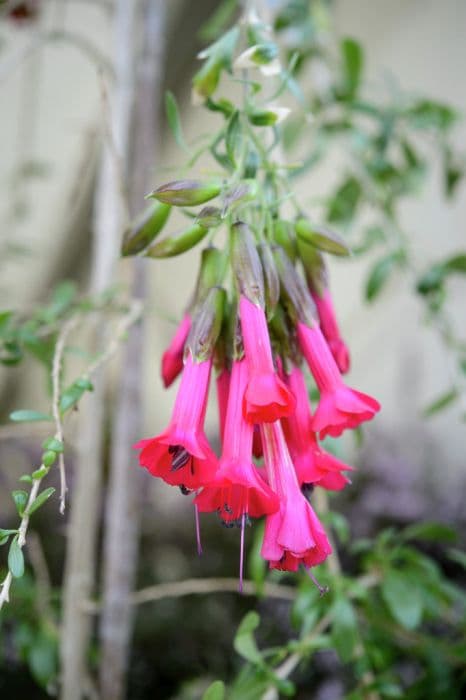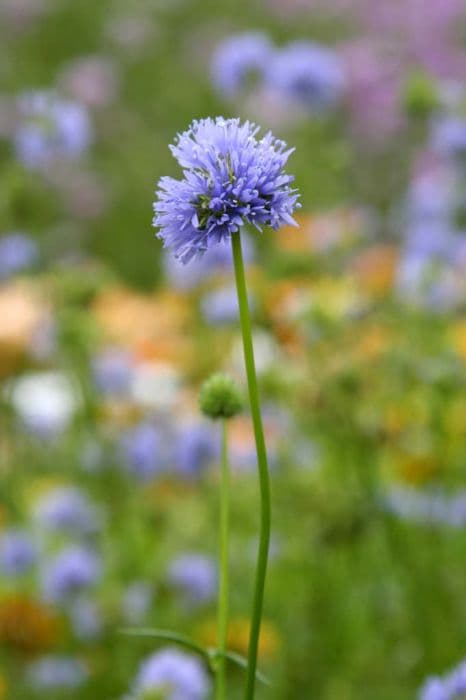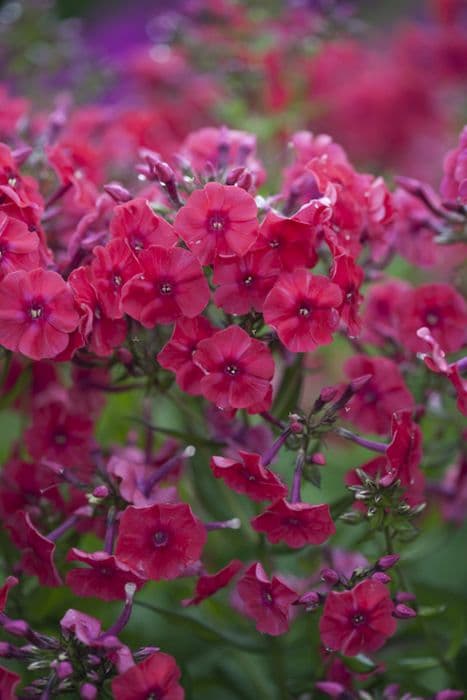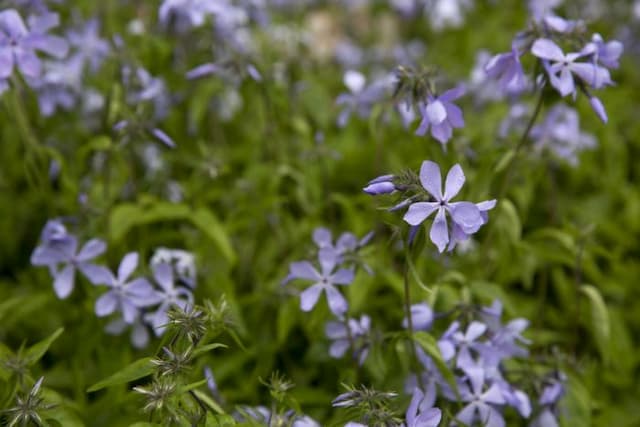Douglas moss phlox Phlox douglasii 'Boothman's Variety'
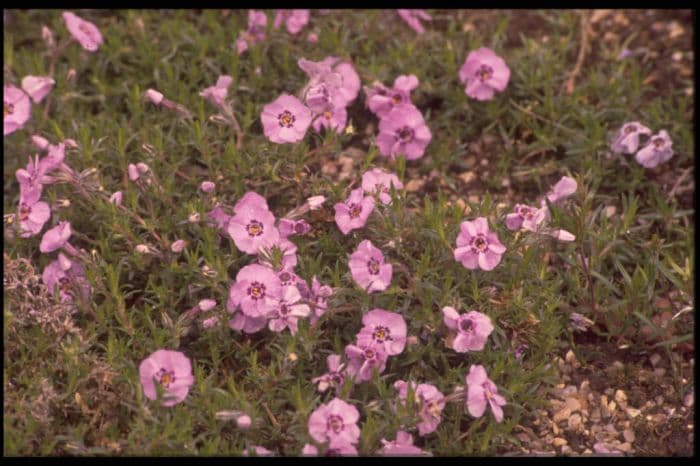
ABOUT
Phlox douglasii 'Boothman's Variety', commonly known as creeping phlox, is a mat-forming perennial plant that creates a dense ground cover. This particular variety boasts small, needle-like foliage that is evergreen, providing year-round interest. In spring, it becomes a carpet of color with its abundant, star-shaped flowers. The blooms of this variety are typically vivid pink with a darker center, offering a striking contrast against the green of the foliage. The flowers are arranged in clusters at the tips of the stems, giving the impression of a plush, colorful blanket draped over the area where it is planted. The leaves and stems often become slightly obscured when the plant is in full bloom due to the profusion of flowers. Noteworthy for its vibrant colors and lush texture, creeping phlox 'Boothman's Variety' is often used in rock gardens, borders, or draped over walls, where its flowering display can be appreciated closely. It's also valued for its ability to attract pollinators like butterflies and its low-maintenance nature.
About this plant
 Names
NamesFamily
Polemoniaceae
Synonyms
Boothman's Phlox, Moss Phlox, Tufted Phlox
Common names
Phlox douglasii 'Boothman's Variety'
 Toxicity
ToxicityTo humans
Phlox is generally not known to be toxic to humans. However, it's always prudent to avoid ingestion of any plant not specifically grown for consumption, as individual reactions can vary and there may be a lack of comprehensive research on the specific effects of this variety.
To pets
Phlox is not commonly listed as a toxic plant to pets. However, the same precautions used for humans should apply to animals; plants not intended for consumption should be kept out of reach of pets to prevent any potential adverse reactions. If a pet does ingest Phlox and shows signs of distress, consult a veterinarian.
 Characteristics
CharacteristicsLife cycle
Perennials
Foliage type
Evergreen
Color of leaves
Green
Flower color
Pink
Height
0.5 feet (15 cm)
Spread
1 foot (30 cm)
Plant type
Herb
Hardiness zones
5
Native area
Northwest America
Benefits
 General Benefits
General Benefits- Ground Cover: Phlox douglasii 'Boothman's Variety' serves as an effective ground cover, creating a carpet of foliage and flowers.
- Drought Tolerance: It is relatively drought-tolerant once established, making it suitable for dry landscapes.
- Low Maintenance: This variety of creeping phlox requires minimal care, making it a convenient option for gardeners.
- Attracts Pollinators: The flowers attract bees, butterflies, and other beneficial insects, which are important for pollination.
- Colorful Blooms: It produces vibrant flowers that add a splash of color to gardens, especially during the spring and summer months.
- Erosion Control: Its mat-forming habit helps prevent soil erosion on slopes and in other erosion-prone areas.
- Rock Gardens: It's well-suited for rock gardens due to its compact growth and ability to thrive in well-drained conditions.
- Winter Interest: The foliage of Phlox douglasii 'Boothman's Variety' can provide visual interest in the garden during the winter months.
- Edging Plant: It can be used as an edging plant along walkways or borders, adding structure to garden design.
- Adaptable: Creeping phlox adapts well to a wide range of soil types, as long as they are well-drained.
 Medical Properties
Medical PropertiesThis plant is not used for medical purposes.
 Air-purifying Qualities
Air-purifying QualitiesThis plant is not specifically known for air purifying qualities.
 Other Uses
Other Uses- Creeping Phlox can be used as a colorful ground cover in miniature railroad or fairy garden landscapes, adding realistic and scaled-down floral detail to these whimsical settings.
- With its tolerance for shallow rocky soils, Creeping Phlox can be implemented in green roofing projects to add biodiversity, aesthetics, and help with insulation of buildings.
- Craft enthusiasts may use dried Creeping Phlox flowers to make natural confetti for events such as weddings or parties, providing a biodegradable alternative to plastic confetti.
- Due to its dense mat-forming habit, Creeping Phlox can be used to stabilize soil on slopes and prevent erosion in areas prone to losing topsoil.
- The plant can be placed in outdoor planters with tall plants to create a "spilling" effect over the edges, which adds depth and fullness to container gardens.
- Creeping Phlox can be used as a living mulch, suppressing weeds around taller plants without competing aggressively for nutrients and water.
- When used in a sensory garden, the soft texture and vibrant colors of Creeping Phlox can provide a visually stimulating experience and an interesting tactile element when brushed or touched lightly.
- Photographers may use patches of Creeping Phlox in the wild or gardens as a natural backdrop for macro photography, highlighting insects or other small subjects.
- Creeping Phlox can be used in educational settings for lessons in plant biology and ecology due to its attractant properties for pollinators and its role in local ecosystems.
- Artists may use the vivid colors of Creeping Phlox petals to create natural dyes for textiles, providing an eco-friendly option for fabric coloring.
Interesting Facts
 Feng Shui
Feng ShuiThe Creeping Phlox is not used in Feng Shui practice.
 Zodiac Sign Compitability
Zodiac Sign CompitabilityThe Creeping Phlox is not used in astrology practice.
 Plant Symbolism
Plant Symbolism- Unity and Harmony - Phlox means 'flame' in Greek, and traditionally, the plant symbolizes unity or harmony, reflecting the way its individual flowers are clustered together to form a cohesive whole.
- Proposal/Acceptance - In the Victorian language of flowers, giving someone phlox was a way of proposing marriage or expressing the wish for a proposal, due to its representation of unity.
- Sweet Dreams - The phlox is also associated with the notion of sweet dreams. Planting it in the garden was thought to invite peaceful slumber and good dreams.
 Water
WaterCreeping phlox should be watered regularly, particularly during its first growing season to establish a deep, extensive root system. Once established, it is quite drought tolerant and watering can be reduced. It's best to water the plant deeply when the top inch of soil feels dry to the touch, which might be once a week, depending on your climate and soil type. Aim to provide about one inch of water during this time, which corresponds to approximately 0.5 gallons for a small to medium-sized plant. Overhead watering should be avoided to prevent fungal diseases; instead, use a soaker hose or water at the base of the plant.
 Light
LightCreeping phlox thrives in full sun to partial shade. It will achieve optimal growth and flowering with at least six hours of direct sunlight each day. The ideal spot for creeping phlox is a location where it can receive ample morning sunlight with some afternoon shade in areas with very hot summers. Avoid placing it in deep shade, as this can lead to poor blooming and a leggy growth habit.
 Temperature
TemperatureCreeping phlox performs best in temperate climates and can tolerate a wide range of temperatures. It is hardy in areas where winter temperatures do not fall below -30 degrees Fahrenheit and can endure summer highs up to 90 degrees Fahrenheit. The ideal temperature range for thriving plants is between 60 and 75 degrees Fahrenheit. You should ensure that the plants are mulched in the winter to protect from extreme cold in zones where temperatures can plummet below its tolerance level.
 Pruning
PruningCreeping phlox should be pruned after it finishes blooming to encourage a dense growth habit and to maintain its appearance. Snipping off the spent flower heads will sometimes promote a second bloom. The best time for pruning is late spring or early summer, once the flowers have faded. It typically needs pruning once a year; however, if the plant becomes too dense, additional thinning may be necessary to increase air circulation and prevent disease.
 Cleaning
CleaningAs needed
 Soil
SoilCreeping Phlox thrives best in well-drained soil with a mix of loam, sand, and compost. The ideal pH for this plant should be slightly alkaline to neutral, ranging between 6.0 to 8.0.
 Repotting
RepottingCreeping Phlox, given its spreading nature, doesn't typically require frequent repotting. It should be repotted or divided every 2-3 years to rejuvenate its growth.
 Humidity & Misting
Humidity & MistingCreeping Phlox prefers average to low humidity conditions and is quite tolerant of dry air, making it well-suited for most garden environments.
 Suitable locations
Suitable locationsIndoor
Place in bright light, water sparingly.
Outdoor
Full sun, well-drained soil, occasional watering.
Hardiness zone
3-9 USDA.
 Life cycle
Life cyclePhlox douglasii 'Boothman's Variety', commonly known as creeping phlox, begins its life cycle as seeds which, under appropriate conditions of light and temperature, germinate in spring. Upon germination, the seedlings develop a primary root system and foliage, forming a low-growing, mat-like ground cover. Throughout the spring and early summer, the plants produce vibrant flowers that attract pollinators, aiding in the plant's reproductive cycle. After pollination, the flowers develop into fruit that contain seeds, ensuring the next generation. As a perennial plant, creeping phlox enters a period of dormancy in the fall and winter, with above-ground growth dying back, while the root system remains alive underground. With the arrival of the next spring, the plant emerges from dormancy, initiating a new growth cycle.
 Propogation
PropogationPropogation time
Spring-Early Summer
Phlox douglasii 'Boothman's Variety', commonly known as creeping phlox, is most popularly propagated through stem cuttings. The ideal time to take these cuttings is in late spring or early summer when the plant is actively growing. To propagate, select a healthy, non-flowering stem and cut a 4 to 6-inch (approximately 10 to 15 cm) section, making sure there are several pairs of leaves. Remove the lower leaves and dip the cut end in rooting hormone. Then, plant the cutting in a well-draining soil mix, lightly water it, and cover with a plastic bag to maintain humidity. The cutting should root in a few weeks, after which you can gradually acclimatize it to normal conditions.
